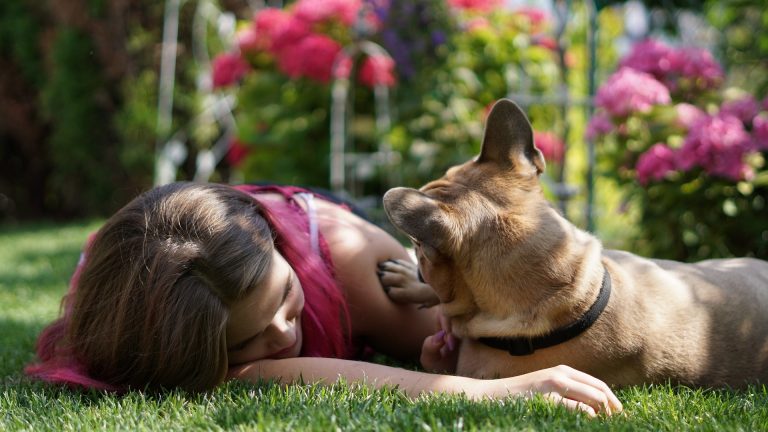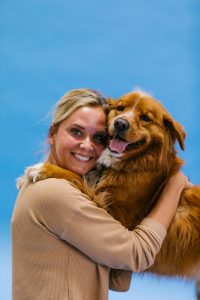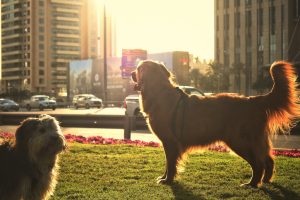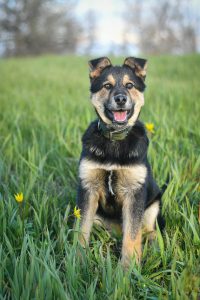You come home after a long day, and your furry friend greets you with a whirlwind of excitement. There’s no mistaking that feeling – your dog adores you! But there’s more to their love language than meets the eye.
Dogs are more than just pets for many dog owners around the world. They are family. Today, I would love to talk about how do dogs show affection.
As most pet parents will tell you, there are countless of ways to show how much you care. But while we often talk about how people can show their dogs some love, today, we will talk about the other side of the story.
Let’s see how dogs express their love.
Body Language
Dogs, similar to humans, are individuals. While there are general signs like tail wagging, it is important to remember dogs are different. That is why you need to pay attention to your dog’s body language and unique cues. Here are some different ways a happy dog will tell you he loves you.
- A wagging tail is a universal sign of showing love. But there are different types of wagging tails. They can be fast or slow, full body or tip-only
- A full-body tail wag is a classic sign of happiness and excitement, and in this case, the tail wagging is rapid and the hips may wiggle
- The slow, and relaxed tail wag also indicates contentment and friendliness, but dogs show it when they calmly greet someone they like. Usually, puppies cannot hold themselves, while an adult dog is calm and knows how to greet people with excitement, but in a well-mannered way
- When a happy dog leans on its human, it is a sign of trust and affection. Many dogs do this, and it is especially common when the female dog owner is pregnant
- Soft eye contact is a signal of love and desire for connection. Your dog is seeking approval and wants to form a deeper bond and connection with you
- Since dogs can read our eyes when they return a relaxed eye gaze, it shows you love them and accept them
- The playful bow posture is an invitation for interaction, be it cuddling or playing
Physical Signs of Affection
Looking at the body language of your furry friend is only half of the story. Dogs can often show love through their behavior. Here are some physical signs of how do dogs show affection.
- Licking, be it the face, hands, or any other part of your body is a clear sign of affection. Some people are disgusted by it. But if you are a dog owner, never run away from licking. Not only it is a way your dog shows puppy love, but when you allow it, it shows your dog you trust them and accept them
- Cuddling is another sign of physical affection that dogs use to seek closeness and security. When a dog completely trusts you, it will turn on its back and wait for a belly rub. It is the ultimate sign of closeness and trust
- Last, but not least, bring dog toys to you. You might think that your dog is clingy and wants to play 24×7. For a while, I couldn’t understand Milo bringing me toys right after a long walk. But it is his way of saying thank you and I love you
- When your furry friend nuzzles your neck or curls up close, he wants as much physical contact with you as possible. It is his sign of telling they feel safe around you
Other Signs of Love
There are many more signs of how do dogs show affection. And they fall under other categories, not just body language and physical signs. For example, a normal dog behavior of a happy dog is following you around. It expresses companionship and desire to be near you.
For example, Milo always wants to be in the room where I am working. He will just lie down comfortably near me. And he doesn’t do anything. He does have his bed, but if I am in the working room, he will come there.
Another sign of affection is enthusiastic welcomes. I opened up with how joyful it is to come back home and find your dog excited and waiting for you. Well, do not take it for granted.
Some dog breeds also show their love by protecting you. There are dog breeds that have stronger protective instincts than others. And they might bark, growl, or show other signs of protective instincts in public.
Now, having a dog that protects you is awesome. But with the proper dog training and socialization, you can make sure that your loyal companion doesn’t go over the top with barking and growling.
Benefits of a strong relationship
Dogs and humans have been co-evolving for thousands of years. Dogs are actually descendants of wolves and have been domesticated by humans to become our pets. Today, dogs provide us with unconditional love and companionship, which can be especially important in helping us cope with loneliness and isolation. Dogs are true family members that can improve our mental health by reducing stress and anxiety. There are many reasons to strengthen the bond with your dog, such as:
- Enhanced training: dogs with strong bonds are more receptive to puppy training
- Improved emotional well-being for both humans and dogs
- Healthier lifestyle: dog owners who take their pets out for walks and playtime tend to be more physically active
- Socialization: when we go out for walks with our dogs, we have opportunities to socialize with other people
- Dogs provide a sense of security and protection
To strengthen the bond with your dog, it’s important to dedicate time each day to walks, playtime, dog training, or just cuddling with your pet. Most importantly, use positive reinforcement to reward desired dog behaviour. Above all, be consistent and stick to routines for stability and understanding. A strong relationship between a pet and owner is built on mutual trust, affection, respect, and understanding.
Final Words
Some dog breeds are more prone to clinginess than others, which is why they are sometimes called “Velcro dogs”. This label is not limited to apartment dogs like Maltese, Bichon Frise, Shih Tzu, and others. Surprisingly, even larger breeds like Golden Retrievers and Great Danes can also be part of this list. However, as a pet parent, having a dog that loves you is the best thing, but it’s important to work on building a strong bond and relationship with your furry friend. Don’t take your dog for granted!






